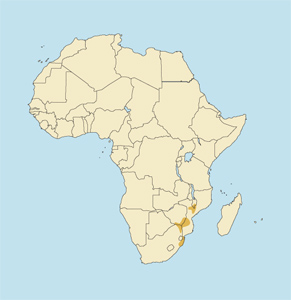 |
Tragelaphus angasi
Nyala (Sp), Südlichernyala, Tieflandnyala (G), Nyala du sud (F), Njala (Af). Also called southern nyala. Called simply "nyala" in southern Africa; however, we prefer "common nyala" so as not to confuse it with the mountain nyala of Ethiopia, a very different animal. "Nyala" is derived from the Zulu inxala for this animal. The specific name was given it in 1848 by English naturalist Douglas Angas, its European discoverer, in honor of his father, George French Angas. At one time it was known as the Angas bushbuck.
DESCRIPTION Shoulder height 39-45 inches (100-115 cm). Weight 220-280 pounds (100-127 kg).
The male common nyala is a medium-sized antelope of striking appearance. It is slender, with a narrow but deep body, and a shaggy, slate-brown coat. Younger males have up to 14 vertical white stripes on each side, but in older animals these are reduced to three or four, or may even be absent. There are white spots on hindquarters and cheeks, a white band on the lower neck, and a white facial chevron. A partially erectile dorsal crest of long hairs extends from the back of the head to the root of the tail-dark brown on the neck and white along the back. A very long, dark mane grows from throat to belly, and the hindquarters are fringed with long dark hairs. The tail is dark brown on top and white underneath. Lower legs are orange. Ears are large. Horns are grown by males only. They are dark with ivory tips, keeled in front and back, and spiral upward in a open curve of 1-1/2 to 2 turns.
Females are very different from males. They are much smaller, without horns, orange in color, with distinct white body stripes and no facial chevron. There is a short, dark dorsal crest, but no mane underneath. (A female common nyala is rather similar in appearance to a juvenile bongo.) Young nyala males are like females, gradually assuming adult coloration.
BEHAVIOR Usually found in small groups, though herds of as many as 30 have been seen. Females and young are usually in groups of about six, young males are in smaller groups, while old bulls tend to be solitary or in pairs. Not territorial. During the rut, males compete for females by displaying and by sparring with their horns, but serious fights are rare. A single calf is usually born in August after seven months gestation. Life expectancy as much as 16 years.
Active mainly in morning and evening. Primarily a browser of leaves and fruit, but also grazes at times. Senses of smell and hearing are good, eyesight only fair. An excellent vertical jumper, able to clear the usual game fence.
HABITAT Dense bush in low country, never far from water.
DISTRIBUTION Only in southeastern Africa: the lower Shire Valley in Malawi, the Zambezi Valley and also in the southeast in Zimbabwe, parts of central and southern Mozambique, and the eastern Transvaal and Zululand in South Africa.
Introduced outside its natural range on private ranches elsewhere in South Africa and Zimbabwe, and in Namibia.
REMARKS Because of its shyness and thick habitat, the common nyala would be very difficult to hunt were it not for the many roads or tracks that traverse hunting areas today. The usual method is to drive slowly along such roads in the early morning and, especially, just before sundown. At these times nyala will move into openings where they can be glassed, and respectable trophies can often be taken rather easily. However, for better horns, the degree of difficulty increases appreciably, because these are carried by the older, wiser bulls. In areas where nyala must be hunted entirely on foot in trackless bush, they are very challenging game animals.
TAXONOMIC NOTES: No subspecies are recognized.
|





